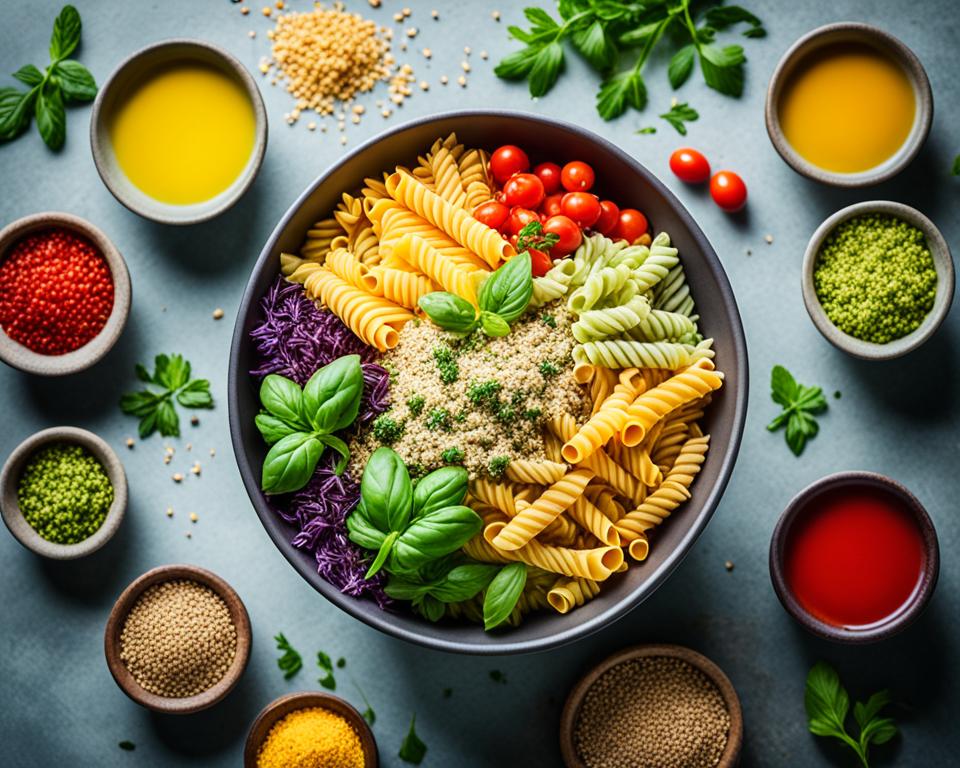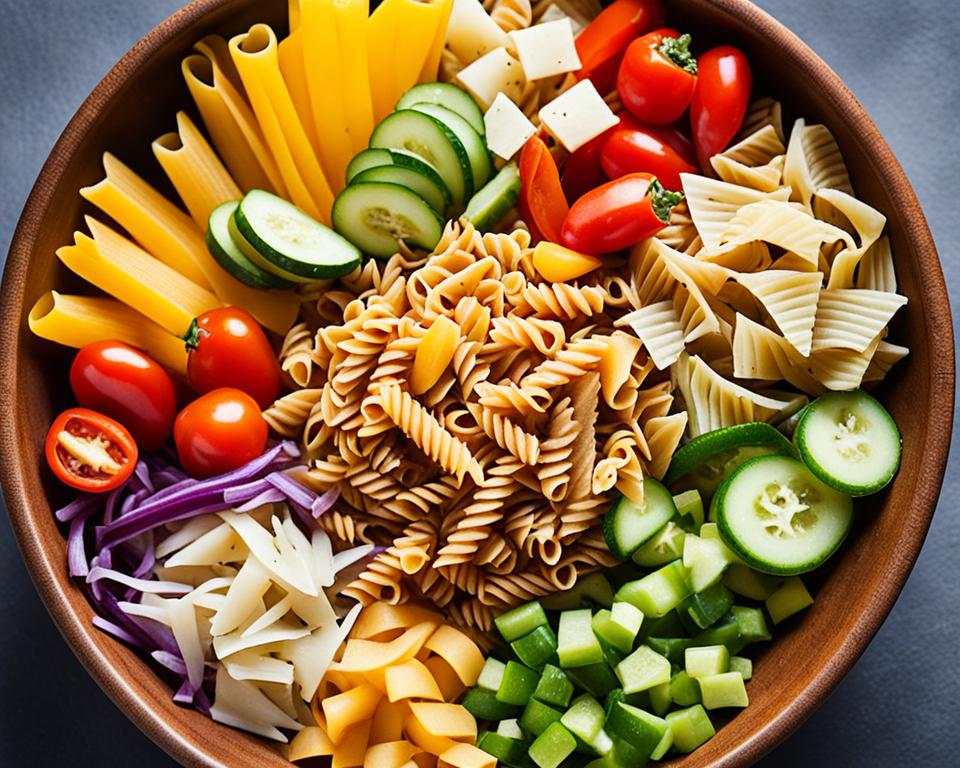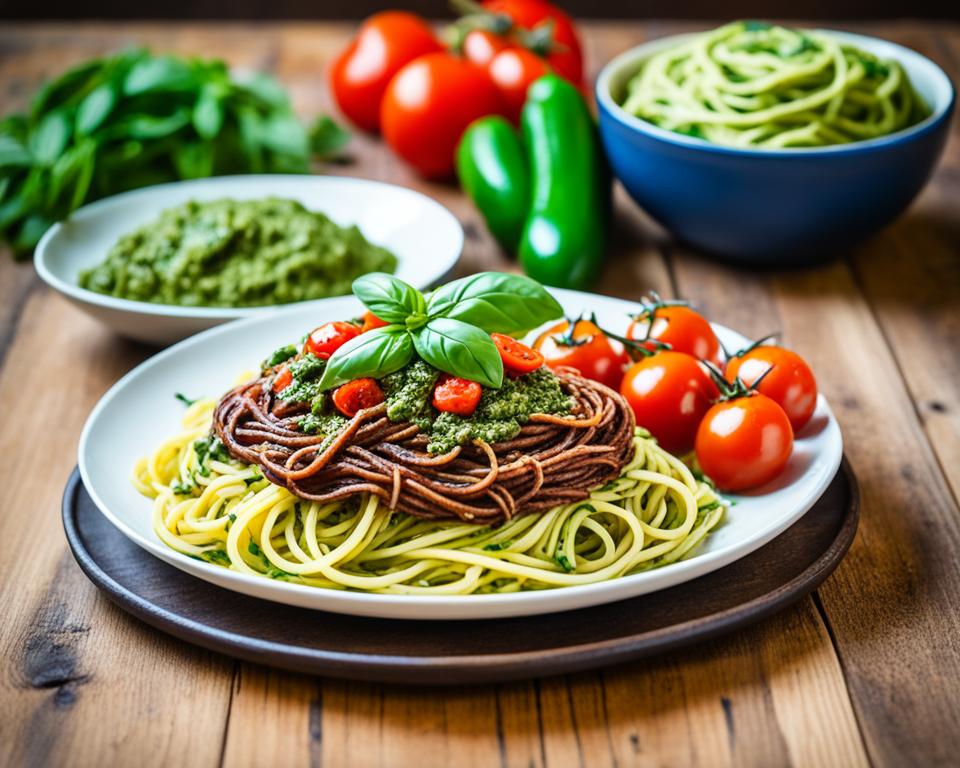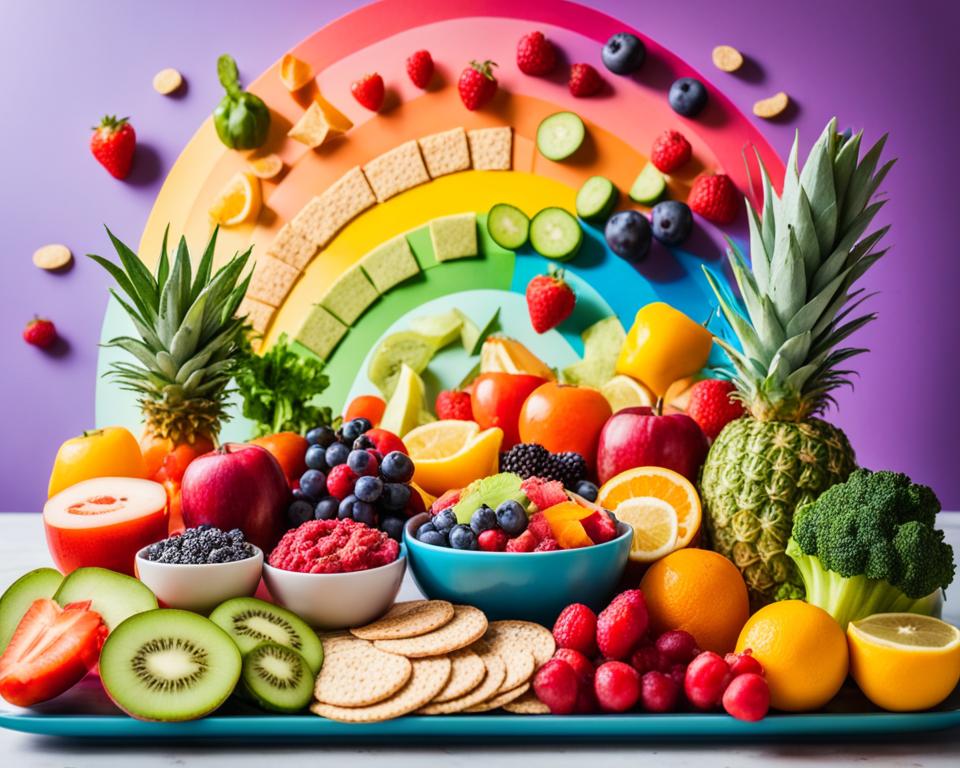Looking for gluten-free pasta alternatives that are both healthy and delicious? Whether you follow a gluten-free diet due to celiac disease, gluten sensitivity, or personal preference, there are plenty of options available to satisfy your pasta cravings. In this article, we’ll explore some of the top gluten-free pasta substitutes, from shirataki noodles to chickpea pasta and more.
Key Takeaways:
- Gluten-free pasta alternatives are available for those who cannot tolerate gluten or choose to avoid it for personal reasons.
- Healthy options include shirataki noodles, brown rice pasta, quinoa pasta, and chickpea pasta.
- These alternatives are packed with nutrients and can offer a range of flavors and textures.
- Try experimenting with different gluten-free pasta recipes to find your favorites.
- Don’t be afraid to incorporate vegetables like zucchini and spaghetti squash into your pasta dishes for added nutritional value.
Brown Rice Pasta
Brown rice pasta is one of the most popular varieties of gluten-free pasta due to its mild flavor and chewy texture. It is a good source of fiber and contains important micronutrients like manganese, selenium, and magnesium. Additionally, the bran in brown rice is loaded with antioxidants, which can help fight oxidative damage to cells and prevent chronic conditions like diabetes, cancer, and heart disease.
If you’re looking for gluten-free pasta brands that offer brown rice pasta, here are some top options:
| Brand | Product |
|---|---|
| Tinkyada | Brown Rice Pasta |
| Jovial | Organic Brown Rice Pasta |
| RiceSelect | Organic Brown Rice Pasta |
| Explore Cuisine | Organic Brown Rice Pasta |
These brands are known for their high-quality gluten-free pasta options, ensuring that you can enjoy delicious and nutritious meals without compromising your dietary needs.
Shirataki Noodles
When it comes to healthy gluten-free pasta alternatives, shirataki noodles are gaining popularity for their unique properties and potential health benefits. These noodles are made from glucomannan, a soluble fiber extracted from the root of the konjac plant. Glucomannan fiber is known for its ability to absorb water and create a gel-like consistency, making shirataki noodles extremely low in calories and carbohydrates.
| Benefits of Shirataki Noodles | Variety | Nutritional Value |
|---|---|---|
| 1. Aid in weight loss | 1. Angel Hair Shirataki Noodles | 1. Zero calories |
| 2. Reduce cholesterol levels | 2. Fettuccine Shirataki Noodles | 2. Low in carbohydrates |
| 3. Stabilize blood sugar | 3. Rice Shirataki Noodles | 3. High in fiber |
| 4. Relieve constipation | 4. Tofu Shirataki Noodles | 4. Gluten-free |
Shirataki noodles are often recommended as a weight loss aid due to their low calorie and carbohydrate content. They can help you feel full without adding excess calories to your diet. Glucomannan fiber has also been shown to reduce cholesterol levels, which may have a positive impact on heart health.
“Shirataki noodles have almost no calories or nutrients”
While shirataki noodles are calorie-free and have minimal carbohydrates, it is important to remember that they have almost no calories or nutrients. To make them a healthy and balanced meal, it is recommended to add nutrient-rich toppings like heart-healthy fats, veggies, and protein.
Overall, shirataki noodles can be a great option for those looking to reduce their calorie and carbohydrate intake while still enjoying a pasta-like experience. Incorporating shirataki noodles into your diet can provide variety and support your health goals.
Chickpea Pasta
Chickpea pasta is a newer type of gluten-free pasta that has gained popularity among those seeking healthy and nutritious alternatives. Made from chickpea flour, this pasta is not only delicious but also packed with essential nutrients.
One of the standout features of chickpea pasta is its high protein and fiber content. These nutrients play a vital role in weight control and overall health. Protein helps to increase satiety and reduce appetite, while fiber aids in proper digestion and promotes bowel function.
By incorporating chickpea pasta into your diet, you can enjoy a satisfying meal that supports your weight management goals and keeps you feeling full for longer periods.
Additionally, research has shown that consuming chickpeas before a meal can have a positive impact on blood sugar levels. The combination of protein, fiber, and complex carbohydrates in chickpeas helps regulate blood sugar and prevent spikes and crashes, making it an excellent option for individuals with diabetes or those looking to manage their blood sugar levels.
Chickpea pasta is also beneficial for heart health. The soluble fiber found in chickpeas can help reduce cholesterol levels, thereby reducing the risk of heart disease. Choosing this gluten-free pasta option allows you to prioritize your cardiovascular health without compromising on taste.
So, whether you have a gluten sensitivity or simply want to explore different pasta options, chickpea pasta is a fantastic choice. Not only does it provide a filling and satisfying meal, but it also offers a range of health benefits.
| Benefits of Chickpea Pasta |
|---|
| High in protein and fiber |
| Aids in weight control and appetite regulation |
| Improves bowel function and digestion |
| Reduces cholesterol levels |
| Enhances blood sugar control |
Quinoa Pasta
Quinoa pasta is a fantastic choice for those seeking a nutritious and gluten-free alternative. Made from a blend of quinoa and other grains, this pasta is not only delicious but also packed with essential nutrients.
One of the standout features of quinoa pasta is its high protein content. Protein is an essential macronutrient that plays a vital role in various bodily functions, including muscle repair, cell growth, and hormone production. By incorporating quinoa pasta into your diet, you can boost your protein intake and support overall health and well-being.
In addition to protein, quinoa pasta is also rich in dietary fiber. Fiber is necessary for maintaining a healthy digestive system and promoting regular bowel movements. It can also help regulate blood sugar levels and prevent spikes in insulin, making it a favorable choice for individuals with diabetes or insulin resistance.
Moreover, quinoa pasta is abundant in micronutrients such as manganese, magnesium, phosphorus, and folate. These minerals are essential for various bodily functions, including bone health, energy production, and DNA synthesis.
Quinoa pasta offers a distinct nutty flavor and a satisfying texture that closely resembles traditional wheat-based pasta. Its versatility allows it to pair well with various sauces, vegetables, and proteins to create a wide array of delicious and nutritious meals.
If you’re looking for a wholesome and gluten-free option to replace regular pasta, quinoa pasta is an excellent choice. With its protein, fiber, and micronutrient content, it can contribute to your overall nutritional intake while satisfying your pasta cravings.

Benefits of Quinoa Pasta:
- High in protein, promoting muscle repair and cell growth
- Rich in dietary fiber, supporting digestive health and blood sugar regulation
- Abundant in essential micronutrients like manganese, magnesium, phosphorus, and folate
- Versatile and delicious, allowing for a wide variety of meal options
Soba Noodles
Soba noodles, made from buckwheat flour, offer a delightful nutty taste and a satisfyingly chewy, grainy texture. Not only are they a delicious alternative to traditional pasta, but soba noodles also offer several health benefits.
One notable advantage of soba noodles is their lower calorie content compared to regular pasta. This makes them an excellent choice for individuals looking to manage their weight without compromising flavor and satisfaction.
Moreover, soba noodles provide a good amount of essential nutrients. They are a notable source of protein, fiber, manganese, and thiamine. These nutrients play crucial roles in supporting overall health and well-being.
Heart Health
Eating soba noodles can contribute to improved heart health. The buckwheat flour used in their production contains compounds that promote cardiovascular well-being. These compounds have been linked to the reduction of cholesterol levels and the improvement of blood flow, ultimately lowering the risk of heart disease.
Blood Sugar Levels
For individuals concerned about their blood sugar levels, soba noodles can be a wise choice. The fiber content in soba noodles helps slow down the digestion and absorption of carbohydrates, resulting in a more gradual rise in blood sugar levels. This attribute can be particularly beneficial for individuals with diabetes or those aiming to manage their blood sugar levels.
To fully benefit from soba noodles’ nutritional advantages, consider pairing them with a variety of vegetables, lean proteins, and heart-healthy fats. This combination will enhance the overall nutrient profile of your meal and provide a well-rounded, satisfying dining experience.
Elevate your culinary repertoire with creative soba noodle recipes that incorporate fresh ingredients and tantalizing flavors. With soba noodles, you can enjoy a nourishing meal that supports heart health and helps regulate blood sugar levels.
| Nutrient | Amount per Serving (100g) |
|---|---|
| Protein | 7g |
| Fiber | 3g |
| Manganese | 0.6mg |
| Thiamine | 0.2mg |
Multigrain Pasta
Many types of gluten-free pasta are made using a blend of different grains like corn, millet, buckwheat, quinoa, rice, and amaranth. Multigrain pasta can be a good alternative to regular pasta and is often a close match in taste and texture.
With a blend of various grains, multigrain pasta offers a diverse nutrient profile that can contribute to a well-rounded diet. Each grain brings its own unique set of vitamins, minerals, and dietary fiber to the table. This combination not only enhances the nutritional value of the pasta but also adds complexity to its flavor.
When choosing multigrain pasta, it is important to check the ingredients label and opt for products that are free from fillers, additives, and gluten-containing ingredients. This ensures that you are getting the wholesome goodness of the grains without any unwanted additives that may compromise the nutritional integrity of the pasta.
Benefits of Multigrain Pasta:
- Diverse Nutrient Profile: Multigrain pasta is a rich source of various vitamins, minerals, and dietary fiber. Different grains offer different nutritional benefits.
- Variety of Flavors: The blend of grains in multigrain pasta creates a unique flavor profile that can enhance the taste of your dishes.
- Dietary Fiber: The combination of grains in multigrain pasta provides a good amount of dietary fiber, which is essential for digestive health and overall well-being.
- Gluten-Free Option: Multigrain pasta is a great choice for individuals with gluten intolerance or those following a gluten-free diet.
Include multigrain pasta in your gluten-free pasta rotation to enjoy the benefits of the various grains it contains. Experiment with different sauces, vegetables, and proteins to create delicious and nutritious meals that cater to your dietary needs.

Spaghetti Squash and Quinoa
If you’re looking for a healthy twist to traditional pasta, spaghetti squash and quinoa are fantastic alternatives to consider. While spaghetti squash resembles strands of noodles when cooked, quinoa provides a gluten-free option packed with protein. Incorporating both spaghetti squash and quinoa into your meals can add nutritional value and texture to a variety of dishes.
Spaghetti Squash: A Vegetable Noodle Substitute
Spaghetti squash is a versatile vegetable known for its noodle-like texture when cooked. To prepare spaghetti squash, simply roast or steam it, then use a fork to scrape out the flesh, which separates into thin strands resembling spaghetti. This nutritious vegetable is low in calories but rich in vitamins and minerals, making it an excellent choice for those seeking a lighter, veggie-centric alternative to pasta.
Quinoa: A Nutrient-Rich Gluten-Free Option
Although quinoa is not shaped like traditional pasta, it is a fantastic gluten-free option that offers a wide array of benefits. Quinoa is a complete protein, meaning it contains all essential amino acids necessary for human nutrition. Additionally, quinoa is packed with fiber, vitamins, and minerals, supporting digestive health and overall well-being. Incorporating quinoa into your meals provides a nutritious foundation and a plant-based protein boost.
Don’t be afraid to experiment with spaghetti squash and quinoa in your favorite recipes. They can be the stars of dishes like pesto “pasta” with spaghetti squash or quinoa-stuffed bell peppers. Mix and match flavors to create unique and delicious meals!
Whether you enjoy the noodle-like texture of spaghetti squash or reap the nutritional benefits of quinoa, these gluten-free alternatives offer satisfying and wholesome alternatives to traditional pasta. Give them a try and discover the delicious possibilities they bring to your table.
Rice Noodles and Zucchini Noodles
When it comes to gluten-free pasta alternatives, rice noodles and zucchini noodles are two excellent options to consider. They provide a lighter alternative to traditional pasta and can enhance the vegetable content of your favorite dishes.
Rice noodles are a popular choice in Asian cuisine, particularly in dishes like laksa, curries, and stir-fries. Made from rice flour and water, these noodles have a delicate texture and absorb flavors well. They are gluten-free and offer a neutral taste that pairs perfectly with various sauces and toppings.
Zucchini noodles, also known as zoodles, are a fantastic way to incorporate more vegetables into your meals. They can be made by cutting or spiralizing zucchini into thin, noodle-like strands. Zucchini noodles provide a fresh and crunchy texture that complements pasta sauces and toppings. They are a low-carb and gluten-free option that adds nutritional value to your dishes.
By using rice noodles or zucchini noodles instead of traditional pasta, you can enjoy gluten-free meals that are lighter and packed with more vegetables. Experiment with different recipes and toppings to create flavorful and satisfying dishes.
Recipes:
| Rice Noodles | Zucchini Noodles |
|---|---|
| Pad Thai with Rice Noodles | Lemon Garlic Zucchini Noodles |
| Beef Stir-Fry with Rice Noodles | Pesto Zucchini Noodles |
| Chicken Curry with Rice Noodles | Teriyaki Chicken Zoodles |
Try these tasty recipes to make the most of rice noodles and zucchini noodles:
- Pad Thai with Rice Noodles: A classic Thai dish featuring stir-fried rice noodles with shrimp, tofu, bean sprouts, and peanuts. The tangy and flavorful sauce brings all the ingredients together for a satisfying meal.
- Lemon Garlic Zucchini Noodles: Light and refreshing, this dish combines zucchini noodles with a zesty lemon garlic sauce. Top it off with some grilled chicken or shrimp for added protein.
- Beef Stir-Fry with Rice Noodles: Tender beef strips, colorful vegetables, and rice noodles come together in a savory stir-fry sauce. Customize with your favorite vegetables and seasonings.
These recipes are just a starting point for incorporating rice noodles and zucchini noodles into your cooking. Feel free to get creative, explore different flavors, and enjoy the variety of dishes you can create with these gluten-free pasta alternatives.
Conclusion
For individuals following a gluten-free diet, there is no shortage of delicious and healthy alternatives to traditional pasta. From options like brown rice pasta, chickpea pasta, and quinoa pasta, to experimenting with vegetable noodles such as zucchini and spaghetti squash, the possibilities are endless. These gluten-free pasta alternatives offer a wide range of flavors and textures, ensuring that you don’t have to compromise on taste or variety.
Whether you are looking for ready-made options from trusted brands or want to try your hand at homemade gluten-free pasta recipes, there is something for everyone. Don’t be afraid to get creative in the kitchen and explore different combinations of ingredients. Making a list of your favorite gluten-free pasta alternatives can help you easily plan your meals and ensure you always have something delicious and nutritious on hand.
Remember, a gluten-free diet doesn’t mean sacrificing your favorite pasta dishes. With the growing availability of gluten-free pasta alternatives, you can still enjoy your favorite flavors while maintaining a healthy and gluten-free lifestyle. So, why not give these alternatives a try and discover a whole new world of gluten-free pasta possibilities?
FAQ
What are some gluten-free pasta alternatives?
Some gluten-free pasta alternatives include shirataki noodles, brown rice pasta, quinoa pasta, chickpea pasta, soba noodles, multigrain pasta, spaghetti squash, rice noodles, and zucchini noodles.
Why is brown rice pasta a popular gluten-free option?
Brown rice pasta is popular due to its mild flavor, chewy texture, and nutritional benefits. It is a good source of fiber and contains important micronutrients like manganese, selenium, and magnesium.
What are the benefits of shirataki noodles?
Shirataki noodles are calorie-free and can aid in weight loss, reduce cholesterol levels, stabilize blood sugar, and relieve constipation. However, they have minimal calories and nutrients, so it is important to add healthy toppings to enhance the nutritional value.
What is special about chickpea pasta?
Chickpea pasta is high in protein and fiber, which can aid in weight control, improve bowel function, reduce cholesterol levels, and enhance blood sugar control. Eating chickpeas before a meal has been shown to reduce blood sugar levels, appetite, and calorie consumption later in the day.
What are the benefits of quinoa pasta?
Quinoa pasta is a gluten-free substitute made from quinoa blended with other grains. It is a good source of protein, fiber, and micronutrients like manganese, magnesium, phosphorus, and folate. Quinoa pasta can help regulate blood sugar levels, improve digestive health, and promote feelings of fullness to prevent weight gain.
How are soba noodles beneficial?
Soba noodles are made from buckwheat flour and have a nutty taste and chewy, grainy texture. They are lower in calories than traditional pasta and provide a good amount of protein, fiber, manganese, and thiamine. Eating buckwheat has been associated with improved heart health, weight regulation, and blood sugar levels.
What is multigrain pasta?
Multigrain pasta is made using a blend of different grains like corn, millet, buckwheat, quinoa, rice, and amaranth. It can be a good alternative to regular pasta and is often a close match in taste and texture. However, it is important to check the ingredients label and avoid products with fillers, additives, and gluten-containing ingredients.
How can spaghetti squash and quinoa be used as pasta alternatives?
Spaghetti squash, when cooked, resembles strands of noodles and can be a healthy alternative to traditional pasta. Quinoa, though not shaped like pasta, is high in protein and can be used as a gluten-free option in a variety of dishes.
Are rice noodles and zucchini noodles gluten-free?
Yes, rice noodles and zucchini noodles are gluten-free options that work well in a variety of dishes. Rice noodles are commonly used in Asian cuisine like laksa, curries, and stir-fries. Zucchini noodles, also known as zoodles, are made by cutting or spiralizing zucchini and can serve as a base for pasta sauces.
What are some gluten-free pasta alternatives for healthy eating?
Some healthy gluten-free pasta alternatives include brown rice pasta, shirataki noodles, chickpea pasta, quinoa pasta, soba noodles, multigrain pasta, spaghetti squash, rice noodles, and zucchini noodles.





